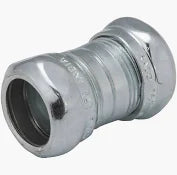RGS Compression Coupling 1/2" to 4"
Please request a quote for pricing information.

RGS Compression Coupling 1/2" to 4"
An RGS (Rigid Galvanized Steel) Compression Coupling is a type of mechanical fitting used to connect two pieces of rigid galvanized steel (RGS) conduit. This coupling provides a secure, leak-tight connection without the need for threading or welding, and it is commonly used in electrical installations or conduit systems for protecting wires and cables. The compression coupling uses a compression fitting mechanism, which includes a compression nut, compression ring (or ferrule), and the coupling body.
RGS compression couplings are widely used for joining rigid galvanized steel pipes (RGS conduit) in various electrical systems, providing a reliable and durable connection that resists corrosion, making it ideal for outdoor or industrial environments.
RGS Compression Coupling (Size Table)
Below is a size table for the RGS Compression Coupling, which lists common sizes of RGS conduit and their corresponding coupling sizes. These couplings are designed to fit rigid galvanized steel conduit (RGS) with nominal sizes typically ranging from 1/2" to 4".
| Nominal Size (Trade Size) | OD of Conduit | Length (L) | Material | Compression Nut/Compression Ring Size | Common Use |
|---|---|---|---|---|---|
| 1/2" | 0.840" (21.3 mm) | 1.50" (38.1 mm) | Galvanized Steel | 1/2" | Connecting two 1/2" RGS conduits in electrical installations |
| 3/4" | 1.050" (26.7 mm) | 1.75" (44.5 mm) | Galvanized Steel | 3/4" | Connecting two 3/4" RGS conduits in electrical systems |
| 1" | 1.315" (33.4 mm) | 2.00" (50.8 mm) | Galvanized Steel | 1" | Used for connecting two 1" RGS conduits in industrial and commercial electrical installations |
| 1-1/4" | 1.660" (42.2 mm) | 2.50" (63.5 mm) | Galvanized Steel | 1-1/4" | Connecting two 1-1/4" RGS conduits in larger electrical systems or industrial setups |
| 1-1/2" | 1.900" (48.3 mm) | 2.75" (69.9 mm) | Galvanized Steel | 1-1/2" | Used in medium to large-scale electrical installations for 1-1/2" RGS conduit |
| 2" | 2.375" (60.3 mm) | 3.00" (76.2 mm) | Galvanized Steel | 2" | Common for industrial and commercial electrical systems with 2" RGS conduit |
| 2-1/2" | 2.875" (73.0 mm) | 3.25" (82.5 mm) | Galvanized Steel | 2-1/2" | Used for large conduit runs in industrial or high-voltage electrical systems |
| 3" | 3.500" (88.9 mm) | 3.50" (88.9 mm) | Galvanized Steel | 3" | Heavy-duty applications for 3" RGS conduit in large commercial or industrial environments |
| 4" | 4.500" (114.3 mm) | 4.00" (101.6 mm) | Galvanized Steel | 4" | Used for very large installations, including power plants or industrial facilities |
Key Dimensions Explained:
-
Nominal Size (Trade Size): Refers to the standard trade size of the rigid galvanized steel conduit (RGS) being connected. For example, a 1" compression coupling is designed for 1" RGS conduit.
-
OD of Conduit: The outer diameter (OD) of the rigid galvanized steel conduit that the compression coupling is designed to connect. This corresponds to the standard OD of the conduit for each size.
-
Length (L): The overall length of the coupling. This measurement is important for determining how much space the coupling occupies in the installation.
-
Compression Nut/Compression Ring Size: The size of the compression nut and the compression ring (ferrule) used in the fitting, which compresses around the conduit to form a secure, leak-tight connection.
Features of RGS Compression Couplings:
-
Material: These couplings are made of galvanized steel, providing excellent corrosion resistance and strength, making them suitable for outdoor and industrial environments where pipes might be exposed to moisture or harsh conditions.
-
Compression Mechanism: The compression coupling includes a compression nut that tightens over the conduit and a compression ring that ensures a secure connection without the need for threading or welding.
-
Durable and Reliable: The use of galvanized steel ensures the coupling is both durable and resistant to corrosion, making it ideal for long-term use in electrical conduit systems and high-voltage installations.
-
Tool-less Installation: The compression coupling allows for easy and tool-less installation. The coupling can be easily threaded onto the conduit and tightened with a wrench, providing a strong, secure, and reliable connection.
Applications:
-
Electrical Conduit Systems: RGS Compression Couplings are mainly used in electrical conduit systems to connect sections of rigid galvanized steel conduit (RGS). These couplings are designed to join conduit sections together securely and protect the wiring or cables running through the conduit.
-
Industrial and Commercial Installations: These couplings are suitable for a wide range of industrial and commercial electrical installations, where rigid galvanized steel conduit is used to protect electrical wiring in environments such as factories, warehouses, and power plants.
-
Outdoor and Harsh Environments: The galvanized steel construction makes these couplings corrosion-resistant, which is ideal for outdoor installations or environments subject to moisture, chemicals, or extreme weather conditions.
-
Heavy-Duty and High-Voltage Systems: RGS Compression Couplings are often used in high-voltage or heavy-duty electrical installations, as they provide a secure, tight seal and reliable connection.
Installation Instructions for RGS Compression Couplings:
-
Prepare the Conduit: Ensure that the ends of the rigid galvanized steel conduit (RGS) are cut clean and square using a pipe cutter or hacksaw.
-
Slide the Compression Nut and Ring onto the Conduit: Before inserting the conduit into the coupling, slide the compression nut and compression ring (ferrule) onto the conduit.
-
Insert the Conduit into the Compression Coupling: Insert the conduit into the compression coupling, ensuring that the ends of the conduit fully seat within the coupling body.
-
Tighten the Compression Nut: Tighten the compression nut using a wrench. The compression ring will compress around the conduit as the nut is tightened, creating a tight, secure seal.
-
Check for Leaks and Secure Fit: After installation, check the connection to ensure it is tight and there are no leaks. Verify the coupling is securely fastened and will not loosen over time.
Conclusion:
RGS Compression Couplings are an essential component in rigid galvanized steel conduit systems, offering a reliable and secure way to connect conduit sections without the need for threading or welding. With sizes ranging from 1/2" to 4", these couplings provide corrosion resistance and strength, making them ideal for industrial, commercial, and electrical applications. Their easy installation, durability, and ability to provide a leak-tight connection make them a preferred choice in various applications where conduit protection is necessary.
Shipping cost is based on weight. Just add products to your cart and use the Shipping Calculator to see the shipping price.
We want you to be 100% satisfied with your purchase. Items can be returned or exchanged within 30 days of delivery.

